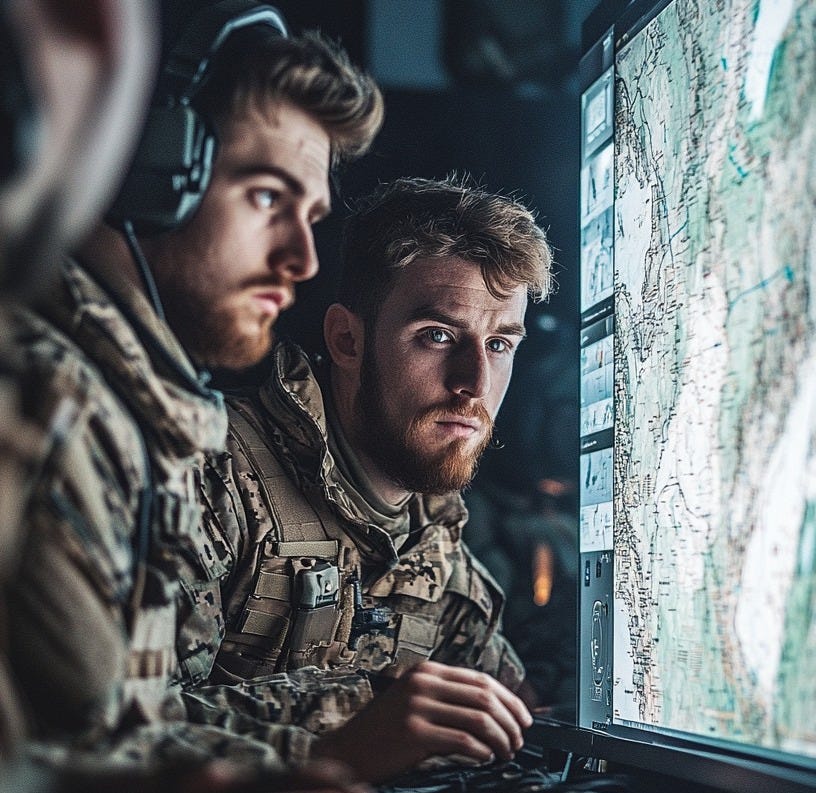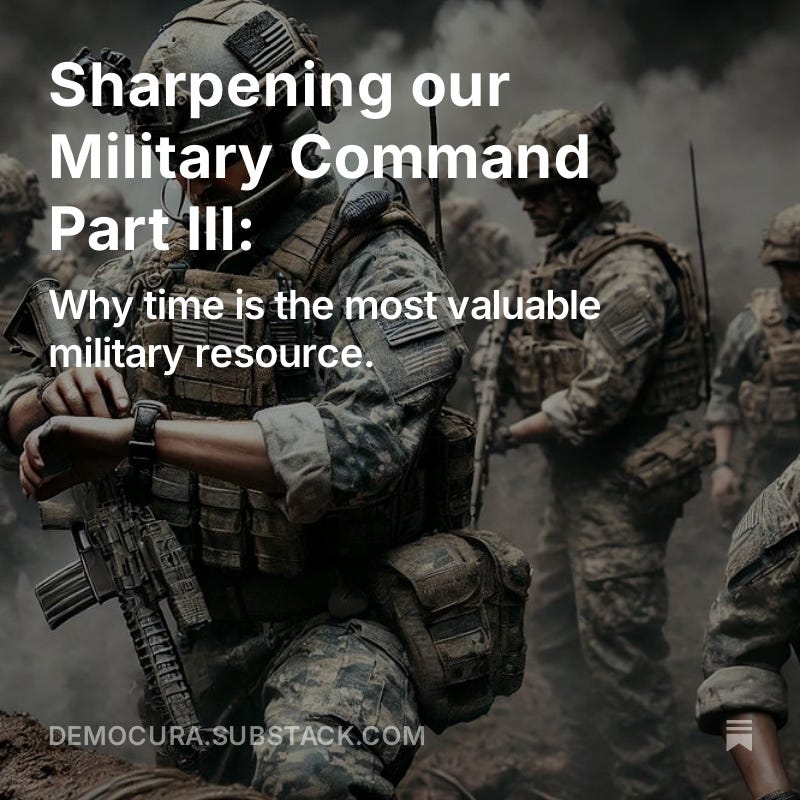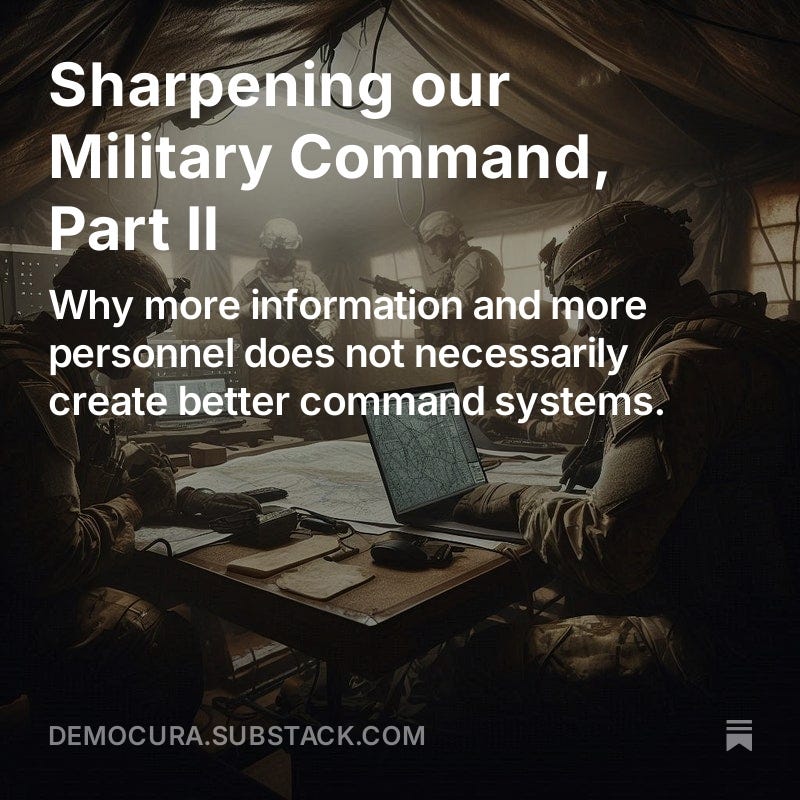Imagine that during battle, some magical genie from a bottle appeared that gave you as a commander a choice, you can either have:
1) A glimpse of the perfect situation of the battle at that very moment, who is where, friend and foe alike, with their current status like morale, ammo, stamina etc. Or,
2) A glimpse into the future, say some 30 to 60 minutes from now, but this information is less accurate compared to option one. You can use the information of either option to your advantage, thereby perhaps changing the battle.
What would you choose? I would definitely choose the second option, to look into the future. If you want to be one step ahead of your adversary, then you continuously have to think and act one step ahead.
Now the strange part: we don’t always try to achieve this during the execution of operations. Everything is geared to getting a better understanding of the current situation, right now. Our processes are fixated on giving reports on the current situation, called a SITREP (Situation Report). I have personally given many current updates during brigade command post exercises, which were focussed on who is where and with what strength and only a limited scope on what would happen next.
Organization and procedures
Within the armed forces there is a distinction between those who plan the operations (S/G/J5: plans branch) and those who execute these plans (S/G/J3: current or operations branch). The plans are handed over to the operations officer, who then executes these plans. Yet we all know that plans never survive first contact with the enemy and this is why command and leadership are needed to make the necessary decisions during the battle. But what if the plan needs adjustments, or an entirely new plan needs to be made? Then either the plans branch needs to get back to work, for the operations branch needs to focus on the current battle, or a small team of the operations branch is tasked to making a plan quickly. Some larger formations even have a 3/5 branch in order to solve these kind of intermediate problems.
Now back to the genie in the bottle and my wish for a glance into the future. If you value less detailed predictions of the future above fully detailed pictures of the current situations, should staff and command posts not shift their focus from trying to achieve near perfect situational awareness, and instead try to continue developing predictions of the likely course of actions, be that of own troops or the enemy? Is the distinction between plans and current within staffs not creating too much of a dichotomy, where operations officers are not willing enough to look into the future, and plans officers too disengaged from the current battle? A counter-argument may be that the operations branch is also responsible for coordinating activities of different sub-units, or for providing the necessary support, like fire-support or logistics. But then again, should they not be trying to predict who needs support when or where, as in push versus pull?
This focus on the current development of the battle is understandable. If something goes wrong, than this is the moment to intervene. However, this is not what mission command is about. The way we monitor and ‘control’ the current battle can undermine the concept of mission command. This is not the main argument of this post, but I could not leave it unsaid.
Technology
Again, if you want to be one step ahead of your adversary, then you continuously have to think and act one step ahead. Yet, all of our processes and the technology supporting these are focussed on providing information on the current situation. Every battlefield management system (BMS) with which I am familiar also visualizes the current situation, with limited options to depict anticipated activities or positions. Moreover, blue force trackers (BFT) depict the current positions of units on the screen almost real-time. This focus on the current battle has only become more entrenched by the use of drones, which can sometimes give us a real time picture of the enemy positions. I already elaborated in this point in a previous post: why more information does not necessarily create better command systems. This post contains a picture of the US president looking at live drone images, which highlights how enables a highly centralized command and a focus on the current situation in extremis.
However, there are two things that are scarce in battle: time and bandwidth. This means that information needs to be few but relevant. Do you want to use the time and bandwidth to receive your troops current amount of ammo, fuel or position? Or do you want to know whether they can still succeed in their mission or on what conditions? For example: “We are progressing more slowly than anticipated, expect to arrive at phase line APLHA 30 minutes later, still able to reach objective.” Information like this gives you a glimpse into the future and options to change the course of the battle. Don’t get me wrong, there are brilliant units and commanders out there who do exactly this. However, most of our formats and systems are focussed on the here and now, because this is information we can have with certainty, we don’t like guesses.
Certainty is absurd
If you want to make predictions on how the battle will evolve in the upcoming hours or so, then you need to start with a good appreciation of the situation at that very moment in order to be able to extrapolate it into the future. This is reasonable. Yet there will always be some uncertainty involved in making predictions about the course of future events. It is therefore important to use probabilities when describing such predictions. These do not necessarily need to be supported by Bayesian statistics, most experienced commanders have a good intuition about these matters, or else can do some quick math and combine it with past experiences. Although one-up may have the overall view of the battlefield, I doubt that they will be able to make the same assessment of the situation on the ground as the commander of that particular unit. The platoon or company commander (or NCO) is the one looking the soldiers in the eyes, and therefore able to assess their ability to handle the situation or more important, their remaining fighting spirit.
This may seem very straightforward, but the problem here is also a cultural one. It is far safer and easier to report on what you know for certain, than make a prediction (educated guess) and be wrong. Let one-up make the difficult assessments and predictions instead. Moreover, if given the choice between ‘certainty’ and something that is only ‘likely’ or ‘probably’, we choose certainty. But certainty does not exist, as I claim in this post with the apt title: ‘Doubt may be unpleasant, but certainty is absurd’.
What will you choose?
Let’s imagine that you play a game of chess, and now you encounter the same genie which grants you the same to options. Why would you choose option 1) a glimpse of the perfect situation of the game at that very moment? You already have it, because you can see the entire board with all the pieces on it. Instead, when you play chess, you are continuously trying to figure out what moves you can make and what (counter) moves your adversary can or will make. You actively try to look into the future and work towards the desired situation. Moreover, you can’t make a plan in advance that will make it to check-mate, unless you are a chess master playing against some novice. It means that you have to continuously update your plan, at least a couple of moves ahead.
Chess may be different, for it does not contain the ‘fog of war’ that always clouds our perceptions. But it is not the ‘fog of war’ we need to counter or battle, it is our adversary. Adversaries have intentions and a nasty habit of not conforming to your plans. Just like in chess, you need to be one step ahead of your enemy in order to win. That means accepting uncertainties, and taking risks.
The views expressed are those of the author and do not reflect the official position of the Armed Forces.
Read the other posts in the series on military command by clicking the images (links) below:
Why is the series named ‘Sharpening our Military Command’? Because of the quote below:
“Give me six hours to chop down a tree and I will spend the first four sharpening the axe.” - Abraham Lincoln
Image: AI created with Stockcake






Game theory (or the book “thinking in Bets”) should be mandatory reading for unit commanders 😏